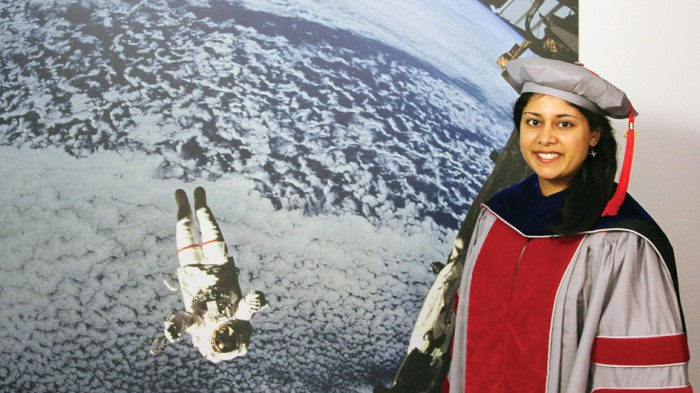Tina Srivastava knows airplanes. She flies them, she’s jumped out of them, and in her senior year studying aeronautical and astronautical engineering, she tested satellite equipment in microgravity on a parabolic flight over the Gulf of Mexico. She has set her sights even higher, aiming to be an astronaut. But for now, her focus is on the emerging Internet of things.
Srivastava is the chief architect at Gigavation, a stealth-mode company cofounded by MIT and Harvard alumni that aims to secure the growing network of physical objects—like cars and homes—with “smart” capabilities. Take cars, for example. “A lot of studies show that there’s a dramatic benefit to passenger safety if cars could warn each other about upcoming hazards,” Srivastava explains. The problem, she says, is security: “You don’t want someone to hack into your brakes or your airbags.” Gigavation’s technology aims to protect automotive, medical, and defense networks, among other things. “It’s the MIT dream—working on a technology that can change the world,” she says.
As an undergraduate Srivastava served for four years on the Class Council, and as its social chair, she planned a skydiving excursion. She led a 40-person team through the process of designing, building, and testing a low-Earth-orbit satellite, a capstone project that landed her on that parabolic flight—and earned her the Lockheed Martin Prize for Excellence in Systems Engineering.

Srivastava joined Raytheon and stayed for six years, ending up as chief engineer of a $40 million radar program. “One of the things that it helped me realize is the importance of looking at things from a systems perspective—realizing how technology is very complex and interconnected,” she says. These insights spurred her to earn a master’s degree from the System Design and Management (SDM) program and a PhD in strategy, innovation, and engineering in aero-astro, management, and engineering systems. She studied the dynamics of innovation, researching how companies and government entities operate. Thanks to the intricacies of funding and the legal and regulatory framework, she says, “it isn’t always the best technologies that succeed.”
In 2014, the systems engineering society INCOSE granted her the David Wright Leadership Award, which includes funding and a two-year charter to forge strategic alliances in the field.
Srivastava volunteers as a FIRST Robotics team mentor. An active member of the MIT Flying Club, she pilots a Cessna 172. But she still wants to be an astronaut, she says: “I apply every time they open up the call.”
Keep Reading
Most Popular
Large language models can do jaw-dropping things. But nobody knows exactly why.
And that's a problem. Figuring it out is one of the biggest scientific puzzles of our time and a crucial step towards controlling more powerful future models.
The problem with plug-in hybrids? Their drivers.
Plug-in hybrids are often sold as a transition to EVs, but new data from Europe shows we’re still underestimating the emissions they produce.
How scientists traced a mysterious covid case back to six toilets
When wastewater surveillance turns into a hunt for a single infected individual, the ethics get tricky.
Google DeepMind’s new generative model makes Super Mario–like games from scratch
Genie learns how to control games by watching hours and hours of video. It could help train next-gen robots too.
Stay connected
Get the latest updates from
MIT Technology Review
Discover special offers, top stories, upcoming events, and more.